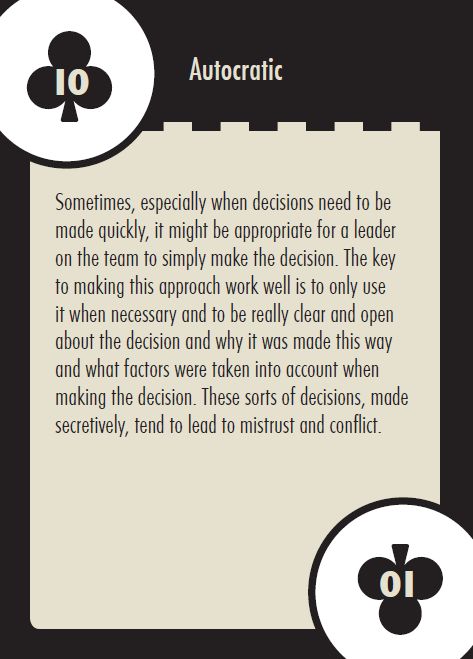I think this says it all. There are just some days when nothing seems to work, but after some yoga or meditation, a brisk walk, a good sleep, a good laugh, or even a short break, most problems become manageable. It just takes some perspective to get out of making a habit of downward spiral thinking.
Save your team some time
Does your team have the same conversation over and over and/or not follow through on your decisions? Clearly documenting decisions is one way to avoid this. It’s also useful to mention the decision making strategy employed and who was involved in the decision as well as the outcome of the decision. This blog is based on the three of clubs from our Teamwork Explorer cards and iPhone app.
One tip to lighten your day
Is this you? It’s certainly been me at times and I have gone through phases of watching too much doom and gloom on TV (and this includes the daily news – sorry all you news junkies who think you can’t live without it – you can). It’s amazing what cutting back on this sort of stuff will do for your energy, optimism and creativity.
Of course, this doesn’t include those compelling evening soaps, too numerous to name at this point 😉
The values/creativity conundrum
Yesterday I posed a values situation … well not entirely as it was also about creativity. I think we often fail to come up with creative solutions when we think values are at risk of being compromised. We also fail to come up with creative solutions because we are thinking in the “tyranny of the OR.” We need to embrace the “genius of the AND” (Collins and Porres), and bring forward our very best “integrative thinking” (Roger Martin).
So from that perspective, here is how to have everyone’s needs met!
(Oh and just to be fully transparent myself, I chose the little old lady as that seemed to align best with my values around compassion and service.)
How Smart are SMART goals??
I have always had a slight resistance to setting SMART goals and was excited to see some research that puts them into perspective. SMART goals can keep us motivated in the short term but the researchers suggest we also need goals that “leap off the page and sing to us” to accomplish truly great things. Here’s to a year of leaping and singing 😉
visuals inspired by my 30 day challenge
It’s Time for the Adult to Take Over
“I feel like I’m playing in the sandbox with a bunch of misbehaving kids,” lamented Pat, a very successful CEO of a large company. She was a collaborative leader who involved her executives in decision making, but the team was under stress and acting like a group of little kids in the sandbox.
“Perhaps it’s time for the adult to take over,” I suggested which led to a fascinating conversation about the challenges of being a collaborative leader. I had learned this from IDEO, a very successful design company, whose innovation teams are very collaborative, creative and emergent, and also, at the right times, directed by a few of the “self appointed adults” to complete certain tasks to ensure that they don’t spin off into complete chaos.
You know it’s time for the team leader to be the “adult” and take over when:
- Problem solving processes have run their course and you need to move forward. Some teams can get into “ideaphoria” and resist closure because they are not confident about their ability to deliver. The team leader needs to force closure on the team and help the team with its confidence.
- Timelines are critical and short and there is no time for collaboration. The team leader needs to provide the plan and delegate to get the task done.
- Some (or all) team members do not have the skills. The team leader needs to provide direction and suggestions about how to tackle the problem at hand.
- The team is not functioning well as a team. Once again, the team leader needs to provide direction and suggestions or delegation of tasks to get things done.
- If a team is under extreme stress, the leader needs to help the team take a time out, regroup and get back on track.
- If there has been a major emergency or catastrophe that is likely to cause chaos, confusion, or strong emotions, the leader needs to step in and provide stability and direction for the team.
The key to switching between a collaborative and autocratic style is to let your team members know, ideally before, but certainly at the time, why you are using this particular style. If you don’t, you risk breaking trust with team members. If you are on a team where there is no formal leader, have the conversation about who the “adults” will be in the above situations. It will save your team time and heartache.
What style do you use? Are there times when you’ve used a more autocratic style?
This blog is based on the 10 of Clubs, Autocratic, taken from our Teamwork Explorer. Written by Tammy.






